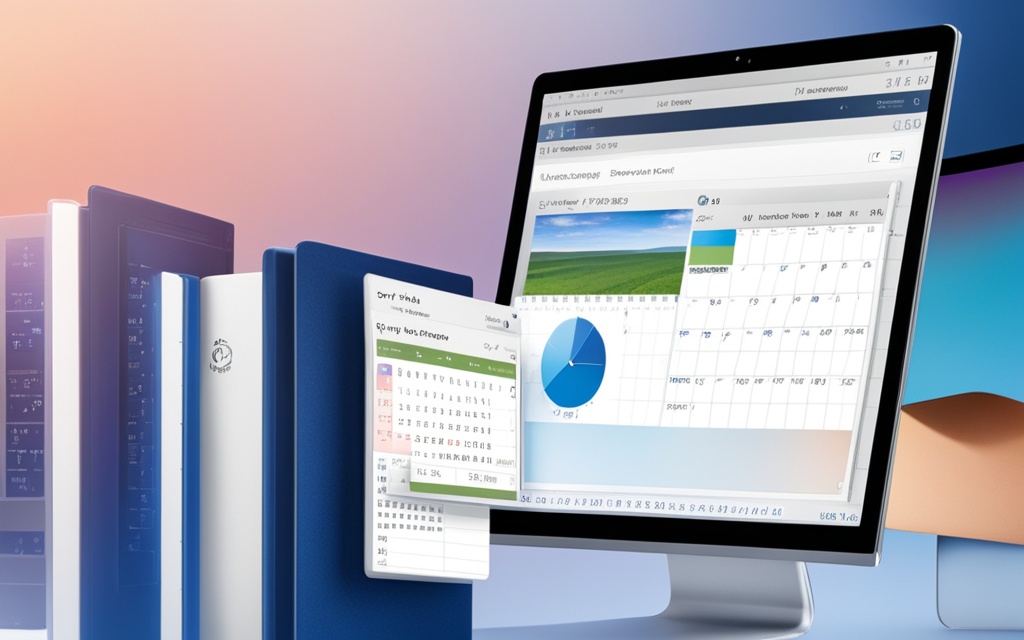Table of Contents
To configure your PC for automatic scanning, use Group Policy for scheduled scans. This ensures regular protection against malware. By setting up automatic scans, you ensure your PC is checked regularly without manual effort.
Here’s how to set up scheduled scans via Group Policy:
- Access the Group Policy Editor by pressing Windows key + R, typing “gpedit.msc,” and pressing Enter.
- Go to Computer configuration > Administrative Templates > Windows Components > Microsoft Defender Antivirus > Scan.
- Choose your scan type. You can pick from Quick, Full, or Custom scans based on your needs.
- Select the day(s) for the scan. Choose one day or several, depending on what works for you.
- Pick a start time for the scan. You can set a specific time or a time range.
- Adjust additional settings like randomizing scan schedules to avoid high resource use. Also, set scans for when the PC is idle.
- Deploy your Group Policy Object as usual to apply these settings to the chosen PCs.
With these settings, your PC will scan for threats automatically, keeping it safe from malware. Regular scans help catch and remove harmful software early.
Key Takeaways:
- Automated scans through Group Policy help PCs check for threats at set times1.
- Choosing scan types, days, and times allows for customised and efficient scans1.
- Settings like scan time randomisation and idle-time scans improve resource use and experience1.
Group Policy Settings for Scheduling Scans
When setting up scheduled scans with Group Policy, many options are available. You can pick either a Quick Scan or a Full Scan. For Windows Defender in Windows 10, 1 means Quick Scan and 2 means Full Scan2. By default, Windows Defender does a quick scan automatically2.
To switch the type of scheduled scan, PowerShell commands are handy2. Those using Windows 10 Pro, Enterprise, or Education can use the Local Group Policy Editor app for this task2. If you can’t access the Group Policy Editor, you can alter the Registry key instead2. In the Registry key, setting the value to 1 selects Quick Scan, and 2 selects Full Scan2.
Administrators can also pick a day for the scan or choose “never” to turn it off. This way, scans fit well with what the organisation needs. They can also set a scan’s start time by noting how many minutes after midnight it should begin3. There’s even a way to shuffle the timing of scheduled tasks for better security3.
To avoid disturbing users, scans can be set to run only when the PC is on but idle. This keeps productivity high without compromising on security3.
| Setting | Description | Reference |
|---|---|---|
| Scan Type | Specifies the type of scan to perform, such as Quick Scan or Full Scan | 2 |
| Day of the Week | Allows selection of the day(s) to run the scheduled scan, with the option to disable it | 2 |
| Time of Day | Specifies the time when the scheduled scan should start by entering the minutes after midnight | 3 |
| Randomize Scheduled Task Times | Enables the option to randomize the start time of scheduled tasks for enhanced security | 3 |
| Start Scan only when Computer is On but not in Use | Ensures the scheduled scan begins when the computer is powered on but not actively being used | 3 |
Group Policy Settings for Scheduling Scans for Idle Endpoints
Finding the right balance is key when scheduling scans. An effective method is to start scans only when the computer is idle. This lets the scan use all available resources and finish quickly.
It’s crucial to configure CPU throttling settings to prevent scan interference. By doing this, the scans run when the PC is not busy. This ensures they don’t slow down other important tasks or the system’s performance.
Group Policy settings are vital for managing scans on idle endpoints. You can adjust these settings to decide when and how the scans happen. This approach helps maintain security without sacrificing user experience or productivity.
Data from4 helps improve scan effectiveness on idle systems. Quick scans provide good malware protection, including against kernel-level threats. They avoid unnecessary repeats by skipping scans under specific conditions, ensuring efficiency.
Considering data size is important for full scans. Depending on the amount of data, full scans can take hours to days. But, according to4, custom scans can be a good option. They target specific areas, cutting down on scan time.
Another factor is the timing of security intelligence updates. As4 suggests, full scans might need to restart if updates become available during a scan. It’s important to align scan schedules with these updates.
Implementing the “Specify the day of the week to run a scheduled scan” policy, as5 outlines, allows setting specific scan days based on Organizational Units (OUs). This helps in early detection of threats by focusing on more vulnerable areas.
Scanning during off-peak hours minimizes the impact on system performance, as5 recommends. This way, users can keep working without interruptions while staying secure.
To troubleshoot Group Policy issues during scan scheduling, use tools like the Resultant Set of Policy (RSoP) or gpresult. Mentioned in5, these tools help sort out policy application issues, making sure scans run as intended.
In summary, using Group Policy settings to schedule scans for idle endpoints strikes a balance between security and efficiency. Insights from4 and5 ensure thorough protection with minimal disruption to users and system resources.
Group Policy Settings for Scheduling Scans for Idle Endpoints:
| Group Policy Setting | Description |
|---|---|
| Start scan only when computer is on but not in use | Ensures scans utilize resources effectively |
| Configure CPU throttling | Avoid interference with critical tasks |
| Specify the day of the week to run a scheduled scan | Set different scanning schedules for OUs |
| Skip unnecessary scans within seven days | Optimize performance during idle periods |
| Custom scan | Scan specific files or folders to reduce duration |
| Scan during off-peak hours | Minimize impact on system performance |
Source: https://pcsite.co.uk/a-brief-history-of-cybercrime-and-its-impact-today/45
Group Policy Settings for Scheduling Remediation-Required Scans
If you need to schedule scans that require remediation, Group Policy settings can help. These settings let you pick the best day and time for a full scan. It ensures the remediation process is completed effectively.
You can select a specific day for the scan or choose “never” to skip it altogether6. This makes it easy to tailor the scan schedule to fit your needs. You can also decide the start time of the scan, down to the minute after midnight6.
By setting up these Group Policy settings, you ensure the needed scans are done well6. Choosing a set day and time for scans offers predictability. It also reduces disturbance to users, as scans occur when computers are least used6.
The default setting for these scans is “never” and starts at 2 a.m6.. Yet, with Group Policy settings, you can change this to suit your needs better.
Adjusting these settings is key for a secure computer network. Regular scans help find and fix security risks quickly. This proactive stance boosts both safety and efficiency.
Group Policy settings give you control over your security and the remediation process6. Setting the scan time according to your needs balances security with productivity.
It’s important to keep reviewing and changing these settings as threats evolve. Being proactive helps you stay ahead of risks and keeps your system safe.
Conclusion
Setting up your PC to run scans on a schedule is key for keeping it secure. It lets you check your computer regularly for any dangers, lowering the chance of unwanted intrusions7. Automating this task means you won’t forget to do it, giving you a sense of safety.
Group Policy settings are handy for picking when and how your PC checks for issues. You can decide on the scan type, choose any day, and set a time that works for you. You can even make these tasks random or only run when your PC isn’t busy8. This flexibility helps make sure your PC’s security doesn’t interrupt your day.
Staying on top of updates for your scanner and its software is also crucial. Adjusting your scan quality based on what you’re scanning and keeping the scanner clean leads to better results9. These steps will make sure your scans are as accurate and useful as possible.
In summary, scheduling scans and adjusting the settings properly helps automate your computer’s defence. It’s a great way to keep your computer safe without constant worry. Knowing your PC checks itself for dangers gives you confidence. Protect your digital world by setting up scheduled scans today. For tips on efficient document scanning, see this link.
FAQ
How do I configure scheduled scans on my PC?
Configuring scheduled scans is quite straightforward using Group Policy. First, open the Group Policy Editor on your machine. Then head over to Computer configuration > Administrative Templates > Windows Components > Microsoft Defender Antivirus > Scan. Here, you can pick the type of scan, set the day for the scan, and choose the scan’s time. Don’t forget to apply your Group Policy Object like you usually would.
What settings can I define when configuring scheduled scans using Group Policy?
You have many options when setting up scans with Group Policy. Choose your scan type- quick or full. You can pick a day for your scans or select “never” to turn them off. Schedule the scan time by inputting minutes after midnight. There’s also an option to randomize the timing of these tasks. Plus, you can decide to start scans only when your computer is idle, making sure they don’t disrupt your work.
Why should I schedule scans for times when endpoints are not in use?
Scheduling scans for off-hours means they won’t kick in unless your PC is idle. This avoids clashes with your CPU’s performance settings. It lets the scan use full resources, finishing faster. However, it might use more resources during the scan.
How can I schedule scans for remediation-required tasks?
To schedule scans for fixing issues, you’ll need to select a day and time. Choose your desired day or “never” to disable the scan. Then, set the scan’s start time in minutes after midnight. This ensures scans are done to address specific problems effectively.
Why is configuring my PC for scheduled scans important?
Setting up your PC to carry out scheduled scans boosts your digital safety. By creating a routine scan schedule, you check regularly for threats. With Group Policy, pick your scan type, day, and time. You can also add options like task randomization and allow scans when the PC is not in use. This keeps your PC secure without bothering you.
Source Links
- https://www.tenforums.com/tutorials/99576-how-schedule-scan-microsoft-defender-antivirus-windows-10-a.html – How to Schedule a Scan in Microsoft Defender Antivirus in Windows 10
- https://winaero.com/change-windows-defender-scheduled-scan-type/ – Change Windows Defender Scheduled Scan Type
- https://support.kaspersky.com/KESWin/12.0/en-US/123523.htm – Running a scheduled scan
- https://learn.microsoft.com/en-us/defender-endpoint/schedule-antivirus-scans – Schedule regular quick and full scans with Microsoft Defender Antivirus – Microsoft Defender for Endpoint
- https://www.windows-active-directory.com/how-to-configure-the-scheduled-scan-in-windows-defender-via-gpo.html – How to configure the scheduled scan in Windows Defender via GPO – Windows Active Directory
- https://learn.microsoft.com/en-us/defender-endpoint/schedule-antivirus-scans-group-policy – Schedule antivirus scans using Group Policy – Microsoft Defender for Endpoint
- https://www.wikihow.com/Connect-a-Scanner-to-a-Computer – How to Install and Connect a Scanner to a Computer: 5 Ways
- https://www.auslogics.com/en/articles/fix-scanning-and-repairing-drive-stuck-issue-win10/ – [FIXED] How to Fix Scanning and Repairing Drive Stuck Issue on Windows 10/11?
- https://www.process.st/how-to/scan-in-microsoft-word/ – How to Scan in Microsoft Word








